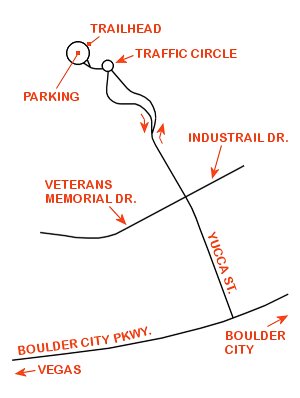Nature Discovery Trail
&
Rock Garden
· · · · · · · · · · ·
Boulder City, Nv.
Overview:
With giant statues of desert animals, a colorful rock garden and great views, Boulder City's Nature Discovery Trail and Rock Garden is an unusual and fun experience for kids of all ages.
This area of Bootleg Canyon Park was conceived well over a decade ago as a place for visitors to learn about the Mojave Desert.
Many native plants have been established and showcased within the beautifully designed rock garden.
Thru a grant from the Southern Nevada Public Lands Management Act the "larger than life" wildlife statues were brought in and together with the native vegetation complete a "unique" ecosystem learning opportunity.
There are interpretative panels that briefly describe "real life" information of the native animals (depicted by the statues) and how adaptation allows them to survive in the extreme desert environment, with a few other plaques describing some of the more well known desert plant species on display.
With extraordinary views of Boulder City, nearby mountains and the surrounding desert the Nature Discovery Trail is an easily accessible, entertaining and informative outing in the Nevada desert.
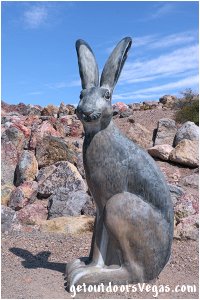
Black-Tailed Jackrabbit is a speed demon, able to run up to 40 miles per hour to escape predators.
An interesting adaptation of the jackrabbit is that they have fur on the bottom of their feet which protects their "pads" from the hot desert ground.
The Black-Tailed Jackrabbit's extremely long ears are not solely for hearing, the long ears also act as "radiators" which dissipate heat helping to regulate their body temperature.
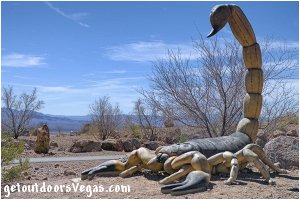
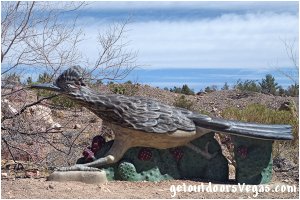
Giant Desert Hairy Scorpion are the largest scorpion in North America.
Being nocturnal, scorpions nest under rocks in daylight and are able to slow their metabolism to conserve energy in extreme desert heat.
Scorpions tend to lie motionless and appear to be dead, however when threatened or hunting unsuspecting prey they "spring" into action by injecting venom with a stinger located at the end of their tail.
Greater Roadrunner are able to fly for short stretches but prefer to run, being able to reach top speeds of 15 miles per hour.
They are know for their strong hunting skills and prefer small birds, rodents, insects and lizards.
Larger prey is "slammed" against rocks, breaking the victims bones while elongating the body, allowing the roadrunner to swallow its meal.
These birds can survive their entire life without drinking water, moisture is acquired from prey.
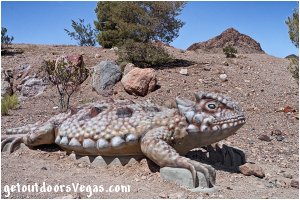
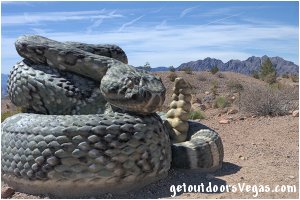
Desert Horned Lizard are often misidentified as a "horny toad".
Looking somewhat prehistoric, this "tough" looking lizard is one of the few harmless inhabitants of the Mojave Desert.
With no toxic venom or painful sting, this lizard relies on camouflage to survive.
Being a reptile and unable to regulate its body temperature, the Desert Horned Lizard warms itself by orienting its back towards the sun in cool weather and buries itself in the soil to escape extreme desert heat.
Mojave Rattlesnake are venomous, having the most debilitating and potentially deadly venom of all North American snakes.
They are pit vipers, utilizing heat sensitive "pits" below their eyes which are utilized to sense prey.
The venom is deployed to kill prey and begin the digestive process, allowing the snake to swallow its victim whole.
These snakes feed on rodents and are an essential component of the Mojave Desert ecosystem.
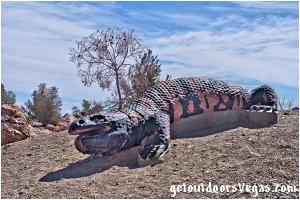
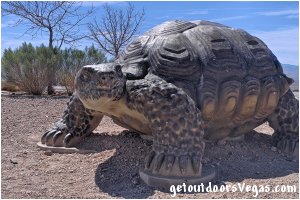
Gila Monster are venomous and are the largest land-dwelling lizard native to the United States.
Despite their size, bright color and slow movement the Gila Monster is rarely seen in the wild, spending 99% of their life underground.
When on the hunt, they can eat up to 1/3 of their body weight, storing excess fat in their tail.
Only needing 3-4 meals per year, they can survive for months between meals.
Desert Tortoise can survive without water for a year or longer and when opportunity arises will drink thru their nose.
Typically however, water intake comes from grasses and wildflowers consumed in the spring.
The tortoise uses its claws to burrow underground for protection and utilizes the excavation as shelter to "brumate" (somewhat akin to hibernation, but not the same) during cooler months of the year.
These adaptations allow the Desert Tortoise to survive the Mojave Desert's extreme conditions.
Information/Tips:
Bring plenty of water / snacks, hat, sunscreen, sunglasses and comfortable walking shoes.
Make sure you have a full tank of gas and a fully pressurized spare tire.
Dogs are allowed on leash.
DON'T forget your camera.
..........
• Nature Discovery Parking amenities:
kiosk, small trash can, dog waste station
Restroom Facilities: none (come prepared)
• Nature Discovery Trail amenities:
information signs along trail
colorful rock garden / native vegetation
bigger than life wildlife statues
shaded gazebo with 2 picnic tables
... gazebo located at trails end
... no trash cans (Pack It Out)
• Nature Discovery Trail: ADA accessible
gentle hill - may need assistance
(use your own judgment)
• Hours: year round, 5am-10pm
• Fees: none
• Limited to No Shade
• No Water Available
..........
nearby: Black Mtn. Overlook
nearby: Hemenway Park
nearby: Historic R.R. Tunnel Trail
nearby: Hoover Dam
nearby: Mendenhall Scenic Overlook
Warning:
• Watch for snakes
• Be mindful of lightning / high winds
• AVOID THE AREA DURING EXTREME HEAT
• You are responsible for your own safety
Trail Directions:
The Nature Discovery Trailhead is located near the Northeast "corner" of the Bootleg Canyon Park Parking Area ("marked" by an information kiosk).
The kiosk describes the areas multiple trails, however does not specifically address the Nature Discovery Trail.
From the kiosk walk Northeasterly along a "connector" trail for 35 feet+- to a trail intersection.
At this point turn Left (Northwesterly) onto the "actual" Nature Discovery Trail and proceed along the paved and winding trail to a "Y" intersection and trail loop.
Proceed in either direction around the loop.
Return by reversing route.
Approx. length of trail (as described) 0.60 miles.
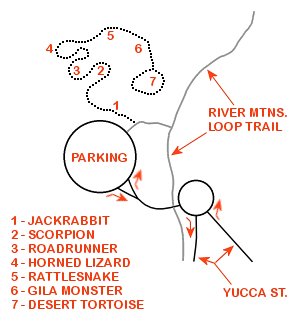
Driving Directions:
From the I-15 (Las Vegas Fwy) interchange with W. Flamingo Rd. proceed South on I-15 for just over 3 miles to Exit #34.
Exit onto the Exit #34 offramp, continue Southerly then Easterly (utilizing the left 2 lanes) eventually merging onto Eastbound I-215.
Travel Eastbound on I-215 for 10.3 miles+- taking Exit #1 (stay in right lane) toward Boulder City (US-93 / I-11).
Travel Eastbound on US-93 / I-11 for 7.1 miles+- to Exit #15B (US-93 Business / Boulder City Pkwy).
Exit onto the Exit #15B offramp, continuing Southerly then Easterly (thru the interchange) eventually merging onto Boulder City Pkwy.
Travel Eastbound on Boulder City Pkwy. for 3.1 miles+- to the intersection of Boulder City Pkwy. and Yucca St.
Turn Left (Northerly) onto Yucca St. traveling 0.3 miles+- to the intersection of Yucca St. and Industrial Rd.
Continue Northerly on Yucca St. traveling 0.4 miles+- (onto a divided section of Yucca St) to a Traffic Circle.
Proceed 3/4 of the way around the Traffic Circle and "exit" Westerly to a short section of road which accesses the "very large" Traffic Circle like parking area.
Return by reversing route.
Approximately 27 miles from central Vegas Strip to the Bootleg Canyon Park Parking Area and the Nature Discovery Trail.
